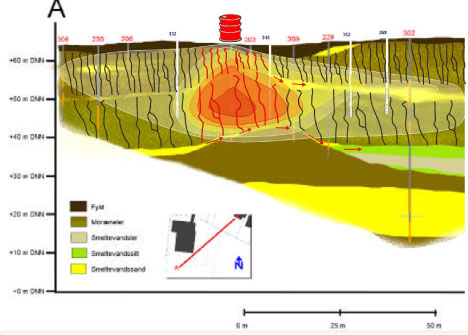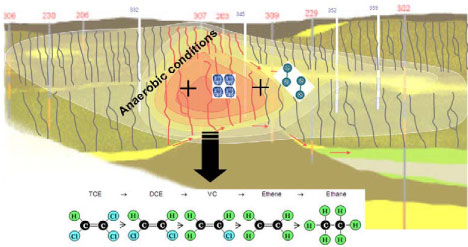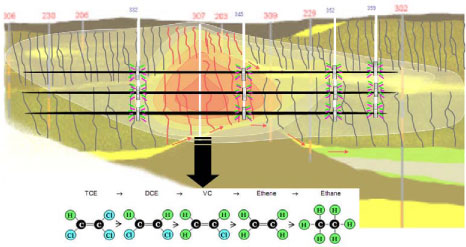Model assessment of reductive dechlorination as a remediation technology for contaminant sources in fractured clay: Modeling tool
1 Background information
1.1 Overview of contamination in fractured clay-till
TCE is a common subsurface contaminant and an important threat to groundwater quality. Many TCE contaminated sites occur in fractured clay systems, and the remediation of these sites is challenging. At such sites, TCE can flow preferentially along fast pathways, formed by the vertical fracture network, and diffuse into the clay matrix. Counter diffusion of TCE to the fracture can take place for hundreds of years after the removal of the contamination source, causing long-term contamination of an underlying aquifer. In Denmark, clay tills are wide spread and this scenario is very common.

Figure 1.1 - Contamination of fractured clay - processes and conceptual model
Recent laboratory and field experiments have shown that bioremediation may be an attractive method for TCE decontamination. Chlorinated solvents can be anaerobically degraded through sequential reactions to a non toxic end product (ethene). These sequential reactions are termed “reductive dechlorination”. This degradation is possible in an anaerobic environment, with the presence of both dechlorinating bacteria and electron donor (generally hydrogen) (Figure 1.2).

Figure 1.2 - Natural dechlorination under anaerobic conditions
Bioremediation, where an electron donor and/or bacteria are injected into the fracture system to enhance reductive dechlorination (Figure 1.3), is a promising remediation technology that may be able to reduce clean-up times.

Figure 1.3 - Fracturing and substrate/bacteria injection to enhance dechlorination
1.2 Modeling objectives
The overall purpose of the project is to assess the effects and time horizons for the cleaning out with reductive dechlorination in clay till. The first phase, which is carried out in parallel, consists in gathering the different experiences for reductive dechlorination as a remediation technology in clay till in Denmark [Mijløstyrelsen, 2008].
The objective of this project is to develop a numerical model of chlorinated solvents transport and enhanced dechlorination in a fractured-clay. This model should enable the identification and characterization of the main processes controlling transport and degradation. The model should be able to assess the clean up times in order to estimate reductive dechlorination as a remediation technology for the low permeability media. The contaminant flux out of the clay system can be quantified, in order to assess the contamination of the underlying aquifer during and after the remediation.
In the following third phase, the two first phases will be coupled by applying the developed model to selected field sites from experience gathering.
Version 1.0 July 2009, © Danish Environmental Protection Agency